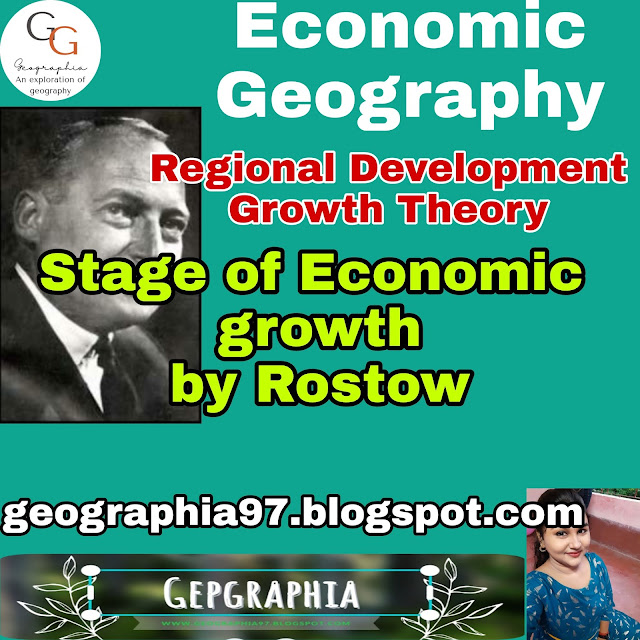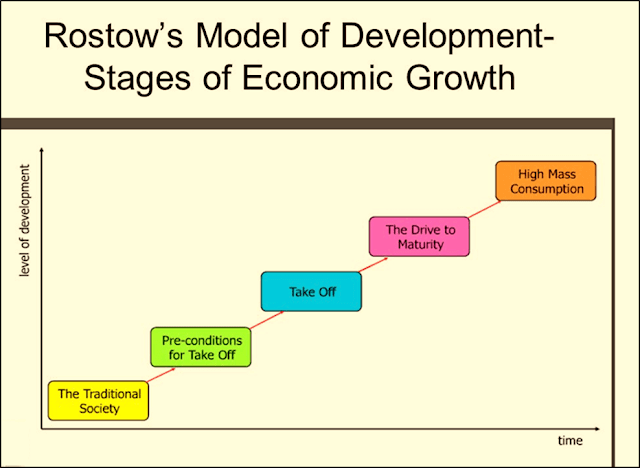STAGES OF ECONOMIC GROWTH MODEL: ROSTOW
- Rostow penned his Stages of Economic Growth in 1960, which presented five steps through which all countries must pass to become developed. he modeled his theory after western capitalist countries, which had industrialized and urbanized. Rostow's model illustrates a desire not only to assist lower income countries in the development process.
- Premise:
- o Lack of adequate investment.
- o The financial gap exists.
- Rostow took an historical approach in suggesting that developed countries have tended to pass through 5 stages to reach their current degree of economic development.
- These are:
- Traditional Society:
- This stage is characterized by a subsistent, agricultural based economy, with intensive labor and low levels of trading, and a population that does not have a scientific perspective on the world and technology.
- This is an agricultural economy of mainly subsistence farming, little of which is traded. The size of the capital stock is limited and of low quality resulting in very low labour productivity and little surplus output left to sell in domestic and overseas markets This initial stage of traditional society signifies a primitive society having no access to modern science and technology.
- In other words, it is a society based on primitive technology and primitive attitude towards the physical World.
- Thus, Rostow defines a traditional society “as one whose structure is developed within the limited production function based on pre-Newtonian science and technology and as pre-Newtonian attitudes towards the physical world”.
- However, Rostow believes in this stage of a society output could be increasing through the expansion of land area under cultivation or through the discovery and spread of a new crop. But the critical fact about this type of society is that there is limit to attainable output per head.
- This limit arises due to the absence of access to modern science and technology. This type of a society is characterized by a hierarchical social structure in which there is little possibility for vertical mobility. The value system that prevails in such a society is called a long-run fatalism. People of these societies think that not much economic progress is possible for them and for their future generations.
- Here, a society begins to develop manufacturing. Agriculture becomes more mechanised and more output is traded. Savings and investment grow although they are still a small percentage of national income (GDP).
- The people start using modern science and technology for increasing productivity in both agriculture and industry, people start viewing the world where there are possibilities of future growth.
- A new class of entrepreneurs emerges in the society who mobilise savings and undertake investment in new enterprises and bear risks and uncertainty. In the sphere of political organisation, it is during this stage that an effective centralised nation state starts emerging. This covers a long period of a century or more.
- These conditions mainly comprise fundamental changes in the social, political and economic fields; for example:
- (a) A change in society’s attitudes towards science, risk-taking and profit-earning;
- (b) The adaptability of the labour force;
- (c) Political sovereignty;
- (d) Development of a centralised tax system and financial institutions; and
- (e) The construction of certain economic and social infrastructure like railways, ports, power generation and educational institutions. India did some of these things in the First Five Year plan period (1951-56).
- Rostow describes this stage as a short period of intensive growth, in which industrialization begins to occur, and workers and institutions become concentrated around a new industry.
- Manufacturing industry assumes greater importance, although the number of industries remains small.
- Political and social institutions start to develop - external finance may still be required. Savings and investment grow.
- Agriculture assumes lesser importance in relative terms although the majority of people may remain employed in the farming sector.
- This is the crucial stage which covers a relatively brief period of two to three decades in which the economy transforms itself in such a way that economic growth subsequently takes place more or less automatically.
Drive to Maturity:
- This stage takes place over a long period of time, as standards of living rise, use of technology increases, and the national economy grows and diversifies. Industry becomes more diverse. Growth should spread to different parts of the country as the state of technology improves, the economy moves from being dependent on factor inputs for growth towards making better use of innovation to bring about increases in real per capita incomes.
- This stage of economic growth occurs when the economy becomes mature and is capable of generating self-sustained growth. The initial key industries which sparked the take-off decelerate as diminishing returns set in. But the average rate of growth is maintained by a succession of new rapidly-growing sectors with a new set of leading sectors. The proportion of the population engaged in agriculture and other rural pursuit’s declines, and the structure of the country’s foreign trade undergoes a radical change.
Rostow believed that Western countries, most notably the United States, occupied this last "developed" stage. Here, a country's economy flourishes in a capitalist system, characterized by mass production and consumerism. Output levels grow, enabling increased consumer expenditure. There is a shift towards tertiary sector activity and the growth is sustained by the expansion of a middle class of consumers. With progressive Industrialisation and urbanization of the economy values of people change in favour of more consumption of luxuries and high styles of living. New types of industries producing durable consumer goods come into existence which become the new leading sectors of economic growth.
Criticism:
o Gunar Mydral has argued that there cannot an inevitable sequence of events described as successive stages of growth. According to him, economic growth is the result of certain economic policies adopted and not the other way around.
o Meier argues that stages in the history of economic growth cannot be generalized from the development experience of some European Countries as Rostow has done. Although a particular sequence may correspond broadly to the historical experience of some economies, no single sequence fits the history of all countries.
o Simon Kuznets argued that many countries which have now reached developed status did so without seeing a significant increase in their savings rate.
o When the external finance has come in the shape of loans from developed countries, interest charges have been incurred which have acted as a drag on economic growth.
o Some Sub Saharan African countries have received significant external finance but have been slow to generate growth - many have remained stuck in Stages 1 or 2..
end...…..
read more
READ MORE
Ncert short note chapter 1 click here
Ncert solution chapter 1 click here
Ncert short note chapter 2 click here
Ncert Solution chapter 2 click here










0 Comments